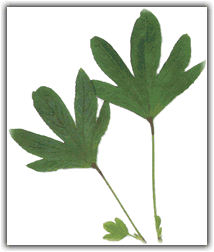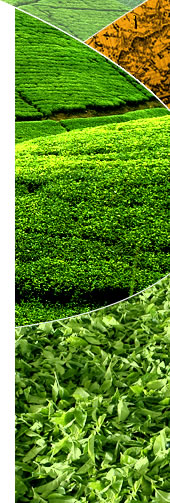| |
 |
![]()
Cooper's Chronicles: Hibiscus
THE DELIGHTFUL HIBISCUS SABDARIFFA
By Barry P.W. Cooper
When next browsing through the tea shelf in your local supermarket, take a moment to look at the ingredient listings of some herbal tea blends. You are sure to find among the components the product hibiscus. Springing into your mind will be the image of a delicate bush, happily growing from a pot sitting on a porch, sporadically bursting forth into flower. The flowers could be pink, white or purple, with delicate, long stems which frequently attract the local bumble bees. This plant is the romantic "rose of China" [h. rosa – Sinemsis].
 Unfortunately, it is not the plant used in herbal tea. That honor is reserved for "Hibiscus sabdariffa". Hibiscus sabdariffa used in the herb tea industry is grown in the Sudan, China, Thailand and Mexico. In the Sudan, it is collected by goat herding nomadic tribes. Because of poor processing conditions, the Sudanese product is frequently a cause for concern because of extraneous matter. Such is not the case in Thailand where there is a sophisticated collection system and an abundance of rainfall resulting in heavy crops, good quality control at the field level and relatively sophisticated price information. The seeds are planted in June or July after the winter monsoon.
Unfortunately, it is not the plant used in herbal tea. That honor is reserved for "Hibiscus sabdariffa". Hibiscus sabdariffa used in the herb tea industry is grown in the Sudan, China, Thailand and Mexico. In the Sudan, it is collected by goat herding nomadic tribes. Because of poor processing conditions, the Sudanese product is frequently a cause for concern because of extraneous matter. Such is not the case in Thailand where there is a sophisticated collection system and an abundance of rainfall resulting in heavy crops, good quality control at the field level and relatively sophisticated price information. The seeds are planted in June or July after the winter monsoon.
In China, seeds are planted in March or April in flats and then transplanted into the ground in May. They are harvested from late November through January. In Mexico, the seeds are sown in the ground in late spring and harvested in the beginning of winter.
Hibiscus flowers are diurnal, lasting only a day, and withdraw into the calyx as the seed pod matures. The calyx is the part used in herbal tea. When the seed pod or capsule ripens, the plants are harvested and the pods separate from the edible calyx. Calyces are picked singularly just as tea leaves are plucked thus ensuring that each harvest bears the heritage of a hand picked crop. After the first flowering, the crops are cut and an additional crop can be harvested if the demand is such that the farmer can increase his cash flow. The calyces from the second crop are much smaller and weaker in flavor than the first harvesting.
The Sudanese hibiscus has a bright red color and a very acidic taste. It is extremely popular in Germany and almost 100% of the crop ends up there. The Chinese material is more sour than fruity and the drying process of the calyx is erratic, as there is little quality control among the farmers. Each farmer harvests his product as he sees fit and dries it in his own fashion. The moisture level of material is thus highly variable and one poorly dried batch of calyx can cause mold, ruining the flavor of the consignment.
In Thailand, the supplier base is wider and more controlled. A series of collectors audit the crop as it is growing, giving an estimate to what the final yield for the country will be. Compared to the Chinese, Mexican and Chinese crops, this is a very sophisticated development. Collectors have long standing relationships with certain growing areas and there is a gentlemen's agreement not to trespass in other collectors' growing regions.
A recent development in Thailand is the introduction of value added processing and one company, Thai-Cha Co., Ltd., now exports tea bag cut material already cut into small pieces ready for the tea bag. All other origins export the bales of material. The advent of value added processing from the country of origin is a recent phenomenon in the herb trade but one that has caused great excitement among the growers, for now they can increase their profits by processing the hibiscus with less expensive labor than found in Germany or the United States.
In Mexico, virtually the entire crop is consumed within the country and the product is controlled by a very few select collectors who run a tight ship. The product reaches the marketplace both as raw, dried calyx and as extracts and powder drink mixes, all of which are very popular south of the border.
Prices for hibiscus vary greatly from year to year and from region to region depending on weather condition, yields, quality and demand.
Hibiscus is an alternative beverage in many tropical countries. The fresh calyces are also made into jellies and jams. In China, the oil of the seed is used medicinally. Hibiscus calyces are commonly called the roselle and in Mexico called Jamaica.
So, there you have it – a noble plant that contributes mightily to one of the most active beverage categories in the world – herb tea!

|
|